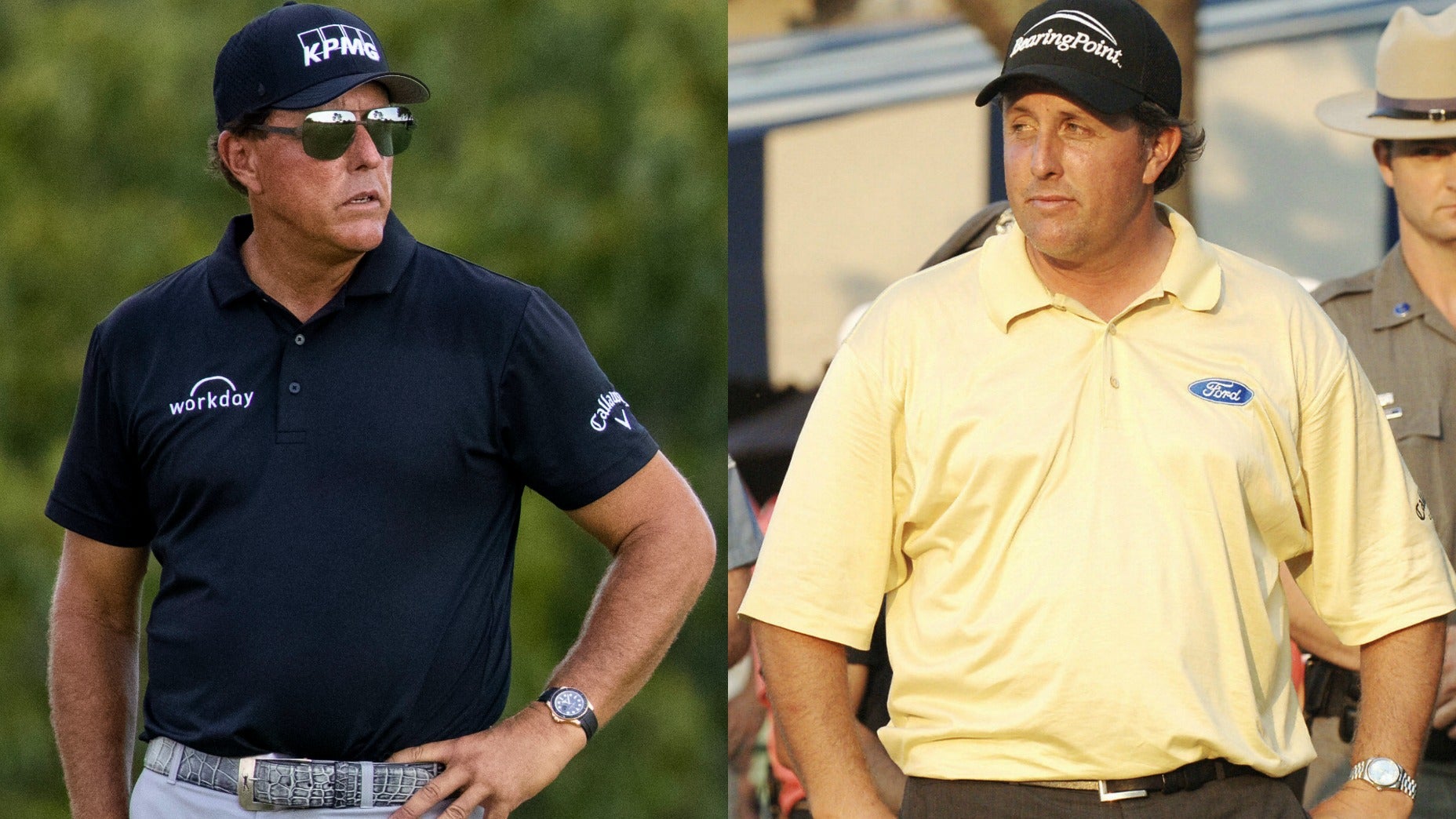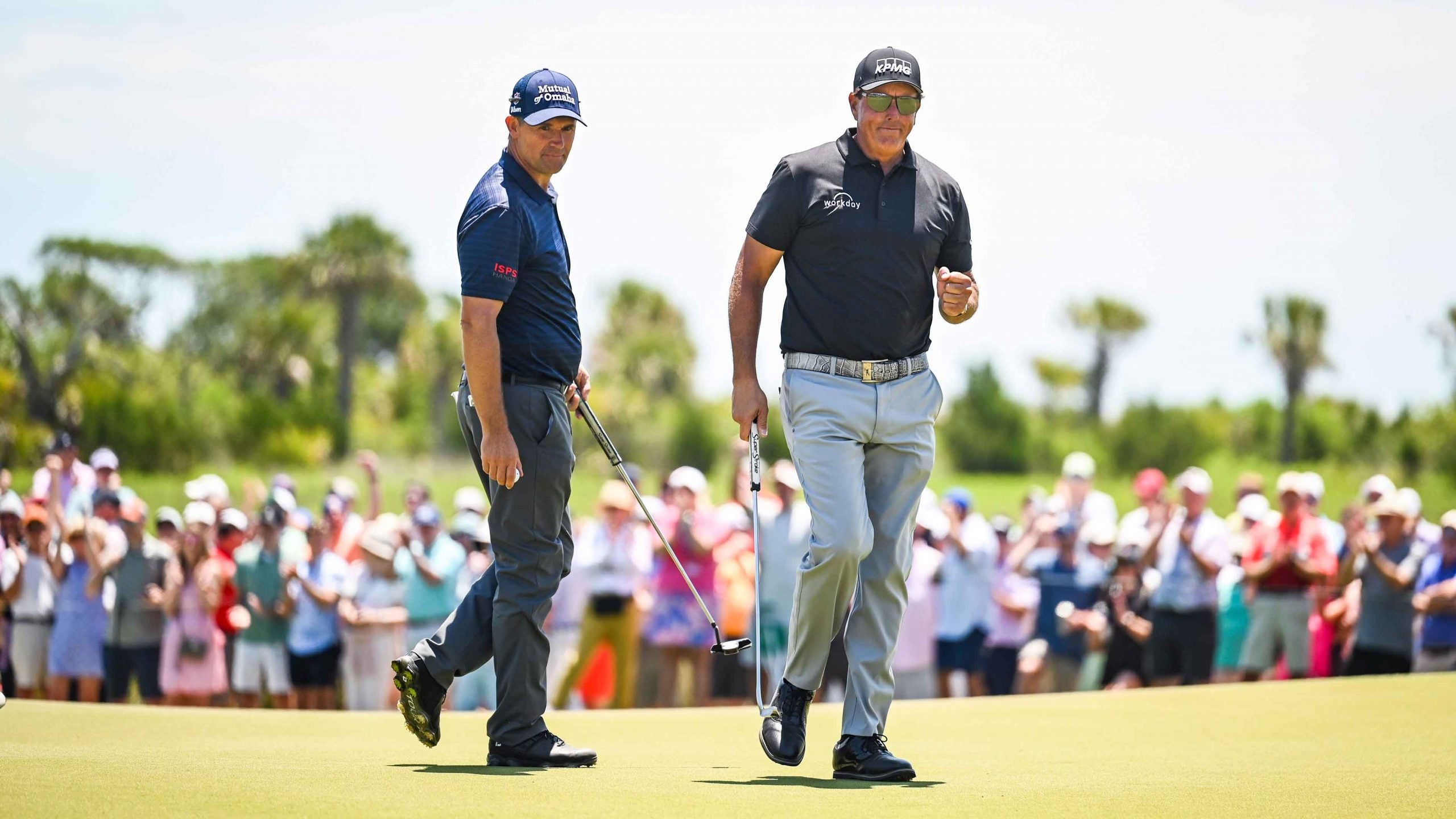Welcome to Play Smart, a game-improvement column that drops every Monday, Wednesday and Friday from Game Improvement Editor Luke Kerr-Dineen to help you play smarter, better golf. Today, we’re talking about Phil Mickelson’s diet.
Phil Mickelson fasts for 36 hours every week but also eats healthier overall!
.But how he could possibly do the unthinkable and win a major at age 50, against men half his age, Phil Mickelson’s answer was simple.
“I worked harder,” he said.
“I work harder physically to be able to practice as long as I wanted to and I’ve had to work a lot harder to be able to maintain focus throughout a round. If I work a little harder, spend a little more time in the gym, eat well, practice hard, there’s no reason why I can’t put it all out there for 18 holes.”

At 50, Phil Mickelson is in the best shape of his life.
Getty Images
And nowhere is that hard work and sacrifice more apparent than in Phil’s physical transformation.
For most of his professional golf career and, indeed, his life, Phil looked like the rest of us: Slightly soft around the middle. And then, rather than letting his career vanish into the twilight, something switched.
“I wasn’t educated,” Phil told me ahead of the 2020 U.S. Open.
“I either wasn’t aware or didn’t want to know the things I was putting
in my body, whether it was diet soda and how toxic that is, or whether
it was the amount of sugar and how much inflammation it causes, or
whether it was the quantity; all of those things, I just kind of shut my
eyes to.”
Armed with a new diet and a sense of purpose, the soft-and-smiley Phil became lean-and-macho seemingly overnight.
Phil Mickelson’s diet:

Phil Mickelson fasts for 36 hours every week but also eats healthier overall.
Getty Images
If you’re looking for a proper deep-dive into Phil’s diet, I’d highly recommend my friend and colleague Sean Zak’s first-hand look trying Phil’s coffee-and-water fast. If you’re looking for something a little more high-level, think of it this way: Generally speaking, Phil eats less of everything and better overall. It’s a good rule to follow for anyone looking to lose weight.
Specifically, Phil structures his eating around periodic fasts. He goes on longer fasts, like the kind Sean tried, and shorter ones. He does three-day fasts every few months as a way of resetting his immune system; he does shorter fasts more often, saying after his final round that he fasts for 36 hours straight once a week.
“It gives my body a chance to reset,” he said.
Phil said he alters his 36-hour, day-and-a-half weekly fast depending on his schedule. Usually, if he’s playing, it’s at the start of the week.
That’s the formula for Mickelson’s diet that works for him: 1.5 days of fasting to cleanse and detox his body so it can recover, 5.5 days of healthier eating overall. But while the results are self-evident, it doesn’t come without sacrifice.
“Food,” Phil said, when asked what his biggest sacrifice was, before taking a more holistic view on his new healthier lifestyle. “I’ve got to eat a lot less and I’ve got to eat better. I just can’t eat as much and I have to let my body kind of recover. But it’s also been a blessing for me because I feel better and I don’t have inflammation and I wake up feeling good. It’s been a sacrifice worth making.”
A sacrifice worth making, indeed.
PGA Championship Notebook Dump: 3 stories we’re just getting around to

At the PGA, Padraig Harrington and Phil Mickelson proved that age is just a number.
getty images
The story of the 103rd PGA Championship was, of course, Phil … and Brooks. And the brutish, breezy Ocean Course. And the 72nd-hole chaos. But there were smaller, less consequential moments and observations. There always are at the majors. In the wake of the thrilling week that was, we asked our three on-site reporters to shake out their notebooks and spin us a yarn they didn’t tell last week.
The Tour de Kiawah
by Michael Bamberger
The best way to get to the golf course was by bike. On Kiawah Island, all through the playing of the PGA Championship, you saw bikes. Not like Bike Week in Daytona Beach, where thousands and thousands of helmeted fellas and gals chug into town on their Harleys. During the Florida Swing, in and around Orlando and Jacksonville, you see the bikers whenever you stop to buy gas or a six. It’s a great scene. Great Americana. But the bike-week scene at Kiawah was not that. Nothing like that. These were bike bikes.
You know the kind. Picture David Feherty on his bike, on the side of the road after another mishap. The 27-speed gear-shifter mangled beyond repair. Not that. Or Rory McIlroy and our own Jonathan Wall on their Peletons. Nothing like that, either.
What this was was hundreds of men, and some women, most of them on the north side of 55, cruising slowly along wide bike paths on fat-tired bikes with foot brakes, big baskets above the front tires, wide, mushy saddles (seats) and upright handlebars. And still the cyclists slouched..

One of the best ways to access the Ocean Course is by bike.
google earth
These were rental bikes, or bikes borrowed from the owners of the houses and villas and condos that were occupied for the week by fans of the golf. Should you wear a helmet while wearing a bike? You should. Was this crowd? It was not. At 4 or 5 or 6 miles per hour, the risks were minimal.
Just like the Daytona Bike Week crowd, this gang had a uniform, too. Shirts with club logos tucked into khaki shorts, the whole package secured by embroidered belts. Golf caps, of course. White golf shoes. Faces slathered with sunblock.
Most of the fans came to the course on giant air-conditioned tourist buses, roaring and noisy and cumbersome on the island’s narrow roads. The bikers snorted, their mode of transportation so superior. Their main struggle was to get enough speed up to keep going forward on a reasonably straight line. Either that, or they were drunk.
And then they’d dismount near the main entrance, where there was a parking lot for bikes, maybe a quarter-acre big, deep in a woods, a shortish walk to the course. They’d hike on in. They were there for the golf, but their iPhones were already giving them credit for some burned calories. Talk about your win-wins.
And then 50-year-old Phil Mickelson became the oldest man to win a major, fending off a player nearly half his age with relative ease.
With history officially re-written, it’s perhaps time to consider the growing body of evidence that the real innovation from the current revolution may not be giving rise to new careers, but in extending the life of existing ones.

Padraig and Phil, 98 years between them.
getty images
It’s undisputable that young players are equipped with better information than ever (and more of it!). Their games have been shaped by that information, which means there’s an underlying level of trust.
But here’s the thing about information: It comes in many forms. Some of it’s good. Some of it’s great! Some of it is just okay. You can have too much information, or not enough. Sometimes the information you have is underdeveloped, flawed or just plain wrong.
It’s why the best information is the kind served with a hearty dose of skepticism, the kind that comes with having been there and done that. To know a salesman when they see one because they’ve fallen for that schtick already, or to bat away something that makes sense in theory but doesn’t work in practice, because they’ve already tried it.
Phil Mickelson, navigating the Ocean Course with his 48-inch high-tech driver and 19th century-style blade putter, embodies the best of both schools of thought. But he’s not the only one. Alongside Phil in the top 5 last week was 49-year-old Padraig Harrington. A month earlier, 48-year-old Stewart Cink won the RBC Heritage. A few months before that 49-year-old Brian Gay again found himself in the winner’s circle. (Cink and Gay both made the cut at Kiawah.) Meanwhile, 63-year-old Bernhard Langer continues to be the man to beat on the Champions Tour.
These are players who have access to the latest and greatest information, then use their life experience to take the essential next step of figuring out how to actually use it.
“As you gain experience, you lose innocence,” Harrington said. “There is a sweet spot on the way up.”
And as Mickelson will tell, sometimes it’s really, really sweet.
Source: golf.com

